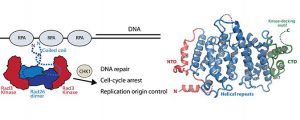New insights into DNA repair
Research from Aarhus University in Denmark is providing new details about the structure of a DNA repair complex, information which could improve chemotherapy treatment of cancer. The new paper, published in The Journal of Biological Chemistry, cites Kerafast’s LOBSTR E. coli Expression Strain, developed by Dr. Thomas U. Schwartz at the Massachusetts Institute of Technology for one-step polyhistidine-tag affinity purification.
Detecting DNA damage
DNA repair is a critical function within cells. DNA is constantly being damaged by metabolic products and environmental factors, such as ultraviolet rays or chemicals. DNA can also be damaged by free radicals; for more on that process, check out our Redox Biology 101 blog post.

This is a model for monitoring and repairing damaged DNA (left figure). The crystal structure of the DNA control protein Rad26 that is responsible for bringing the Rad3 kinase to damaged DNA and starting repair signalling (right figure). Credit: Kasper Røjkjær Andersen.
Therefore, to maintain genome integrity, cells have evolved various mechanisms to monitor and repair DNA damage. One such mechanism involves the protein kinase Rad3, which helps coordinate the DNA damage response and sends out signals to ensure cells do not divide before the damage is fixed. It is known that the protein Rad26 is responsible for bringing the Rad3 kinase to areas with DNA damage. Together, these two proteins form the Rad3-Rad26 DNA repair complex. However, structural knowledge about this complex and the kinase recruitment step has been limited.
Improving chemotherapy treatment
The new research paper, authored by Dr. Kasper Røjkjær Andersen, revealed the crystal structure of the recruiting protein Rad26. It also identified that Rad26 uses its C-terminal domain and a conserved motif to recruit the Rad3 kinase, as well as modeled the quaternary structure of the entire Rad3-Rad26 complex.
This new structural information about the Rad3-Rad26 complex could aid in the development of improved cancer therapies. DNA repair pathways provide a way for tumors to resist chemotherapy, by enabling cancer cells to repair the DNA damage caused by chemotherapy treatments. Therefore, researchers are working to create Rad3 inhibitors that make cancer cells more susceptible to chemotherapy.
Do you work in this area of research? You may be interested in one of our reagents for studying DNA damage and repair, including:
- DNA-RNA Hybrid [S9.6] Antibody from National Institute of Allergy and Infectious Diseases/NIH
- DNA-Binding Fluorescent Probes from University of Miami
- NIH 3T3 Translocation Cell Lines from National Cancer Institute/NIH
- Protein-Nucleic Acid Complex Crystal Screen from Wake Forest School of Medicine


